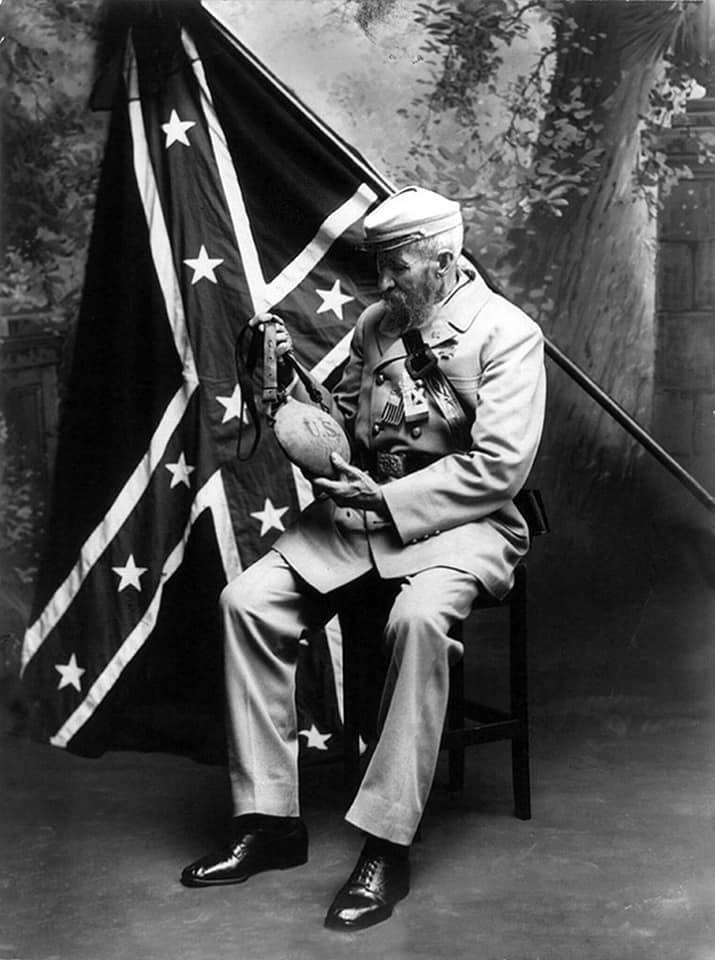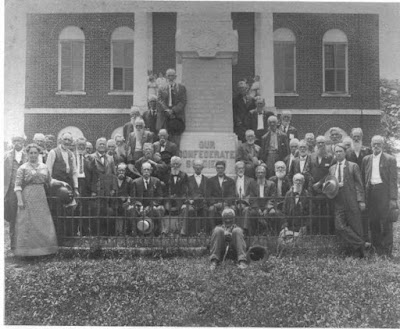About Publications Library Archives
heritagepost.org

Preserving Revolutionary & Civil War History

Preserving Revolutionary & Civil War History







The following newspaper accounts also show that Black Confederates were far from forgotten by their local communities, and acknowledged by their fellow Confederate Veterans for their service. Many of these Confederates of Color were buried with full honors — and in Confederate uniform!


Black Confederates were very much a part of the original United Confederate Veterans and were in fact honored as any other Confederate veteran was locally by their peers (white and black) all throughout the late 19th and early 20th centuries. Many of those same Black Confederates were often buried in Confederate uniforms with battle flags draping their coffins and carried by white and black pallbearers who were also former war veterans.
Black Confederate Veterans attended many of the United Confederate Veterans reunions following the end of the war and well into the 1940s, something that modern-day social justice warriors will scream could not have been possible because of the Jim Crow segregation at the time.
Honoring The Black Confederate Veteran

One of the arguments of Deniers is simply to scream racism — another popular tune on that broken record they love playing over and over and over and over and over. They argue strongly that the racism of the time prevented black men to be perceived as equals in any way.
As I said before, I am not going to paint some pictures that racial attitudes during the War and well after it in the American South were anything less than terrible by the standards we hold to in the 21st century.
It must also be acknowledged that, despite the efforts of some former Confederate veterans, many Black Confederate veterans did not receive pensions for their service in the War for decades. Some Southern States like Tennessee for example awarded pensions to Black Confederates not long after the end of Reconstruction, while other states like South Carolina took at long as 1932 to finally provide financial aid for their Confederate service, by which time many of these veterans of color were long dead.
Despite being part of an army that lost a war, the memory of the Confederate soldier was revered in the South following the Reconstruction Era (1867-1876). Indeed I have pointed out on several occasions that efforts to honor the dead happened almost immediately following the War, even if it was little more than Southern women decorating the graves of the honored dead. Many of the monuments you see standing today across the South honoring the Confederate Veteran were largely built around the turn of the century due largely to the wide-spread poverty in the region following the War. Some of those monuments took decades to raise money for, and for many, were the only headstones that grieving families would ever have.
Because of this, the United Daughters of the Confederacy took it upon themselves to acknowledge the service of these men and boys by creating a special commemorative medal in 1899 called the Southern Cross of Honor.
This medal could only be bestowed through the United Daughters of the Confederacy and was given in recognition of loyal, honorable service to the South. It could not be legally purchased and only a Confederate veteran could wear it.
In point of fact, this rule was enforced so stringently that the State of Virginia Code section 18.2-176(b) (which actually remains in effect today) makes it a Class 3 misdemeanor, punishable by a fine of not more than $500 (US) to “wear any Southern Cross of Honor when not entitled to do so by the regulations under which such Crosses of Honor are given.”
In short, only an honored and acknowledged Confederate veteran would be allowed to wear it in public.
Approximately 18,761 of these medals were issued to Confederate Veterans. Now then, consider that there were likely still around (and this is a guess mind you) oh say, a few hundred thousand of these aged veterans left at the turn of the century. That means that this award was likely only given to men who were recognized by their peers as having distinguished themselves during the War.
Needless to say that impersonating a Confederate soldier — stolen valor as we would call it — would land someone in really hot water, especially a Black Southerner considering the attitudes during the Jim Crow era.
So why is it that the ladies of the UDC awarded some of these distinguished medals to many Black Confederate veterans?
For that matter, what about white Confederate veterans’ attitudes towards their fellow Confederates of color?
This folks is perhaps the greatest point of this argument.
As I pointed out before many Black Confederate veterans were not given pensions, and some had to rely on the charity of their fellow veterans, who would “pass the hat” around and provide for these men. Many white Confederate veterans also lobbied hard to see to it that these African-American veterans were admitted to Confederate Soldiers Homes in their old age, and receive the pensions they’d earned through their service.
After the War, at UCV Reunions, many of these men were often recognized as veterans by the soldiers they served with and counted by those men as part of the unit. As I demonstrated before with photographs from several reunions of the United Confederate Veterans, Confederates of color were present at a number of these events. Obviously, if these men were viewed as anything less than fellow veterans by the other former Confederates, they would have been told to hit the road and never come back.
During the reunion at the 50th anniversary of the Battle of Gettysburg (July 1-3) in 1913 several Black Confederate veterans were in attendance. There is an incredible story that the people who set up the event didn’t account for their presence and had no accommodations arranged specifically for these men. In answer to this, a group of Alabama Confederate Veterans offered to let these men share their own tents with them.

As the ranks of the thin gray line passed over the river into the undiscovered country beyond, the aged Confederate veterans were laid to rest in Southern soil, sometimes as groups.
One such case is the men of the Atlanta Confederate Soldier’s Home buried with other Confederate soldiers and veterans at the Confederate Cemetery in Marietta, Georgia. Among these men is the grave of a Black Confederate Veteran named Bill Yopp, who served as a drummer in Company H, 14th Georgia Infantry Regiment. Yopp was a former slave and Confederate veteran who lived in his old age at the Soldier’s Home along with other veterans, including his former master, Captain Thomas Yopp.
While the CS government as a body might not have officially recognized these men as soldiers, the men who served with them certainly counted them as one of their own; both as a soldier, and later on as a veteran.
If the United Confederate Veterans themselves — the men who actually fought and lived beyond the war — recognized those Southern men of color as soldiers and veterans, then their opinion counts for more than a piece of political legislation.
It is the men who wore the hallowed grey and butternut of the South who decided that these men were one of them. They all served in the same units, suffered the same terror of battlefield bullets, the same horrors of the field hospitals, the inglorious deaths of disease, the indignities of the prisoner of war camps, and the final surrender and defeat together. They lived together, they fought together, some died and were buried together on the field, and more importantly many survived together.
It was the United Confederate Veterans themselves who accepted these Confederates of Color as fellow veterans at reunions, who lobbied to get these men pensions for their service, and who were later buried them alongside their fellow soldiers with all military honors.
In the end, it is the opinion of those veterans who witnessed the horrors of war on the battlefield together that hold the most weight in the final review. Not a piece of paper, not a government order, and most certainly not some agenda-driven historian. Their service and those of the men they fought with were paid for in blood that ran the same color no matter what color the skin that held it in; and that noble Southern blood is much thicker than ink folks.
CREDIT: C.W. Roden https://southernfriedcommonsense.blogspot.com